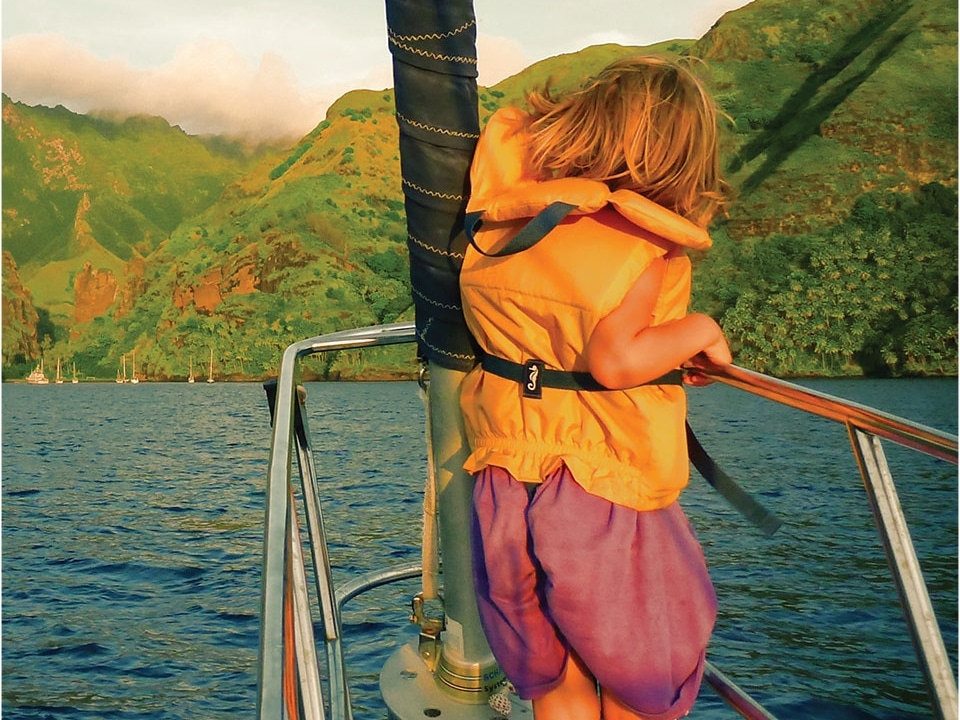
Certain decades in one’s life just seem to make it simpler to get to that point of untying the dock lines of your own cruising boat and sailing for distant shores. My wife, Windy, and I first did it in our 20s—before the house, the kids, and the careers. We had few ties to cut before sailing away for seven months to visit eight countries on a small, coastal, classic-plastic cruiser that I bought for $8,500. For many others, the cruising lifestyle is a goal only realized once they reach their golden years, when they no longer have to report to the office each morning and the kids are off on their own. These folks usually plan extensively for their escapes, and they possess the time and means to make it accessible.
But what about the folks who are, as author and blogger Mike Litzow has written, “serving the triple demands that people in their 30s and 40s find themselves beholden to: raising the kids, making a living, and, with whatever energies are left over, trying to organize things around some vision of what might add up to a satisfying life”? How do these families manage to cast off and anchor among the 20-somethings and the retirees? Given the apparent difficulties, what compels these sailors to make such a transition?
In just the past few months, which my family spent cruising along the Pacific coast of Mexico, my wife, myself, and our two daughters have crossed wakes with more than a dozen families who found such a path to the cruising lifestyle. Talking with several of them, I recognized familiar themes, though all of their stories were unique. I also heard what I knew: Yes, it’s hard work for a family to break free from a conventional life and transition to a vagabond existence aboard, but it’s definitely doable, even within modest means. Here are the stories of five such families, beginning with my own.
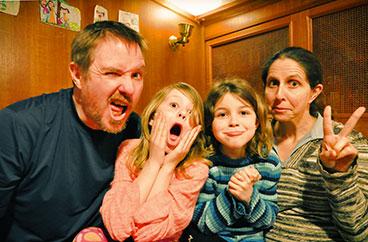
In the late spring of 2011, my wife, Windy, and I quit working, sold our house and possessions, and drove from Washington, D.C., to Puerto Vallarta, Mexico, where we kept the Fuji 40 that we bought the year before, to begin our open-ended cruising life. We’ll keep cruising as long as we all still enjoy it and the money doesn’t run out.
We always knew that we wanted to go cruising again, but we assumed that it wouldn’t happen before Windy and I reached normal retirement age. Having kids changed our assumptions and priorities. After a couple of years tending to demanding, full-time careers while paying someone else to tend to our full-time child, we began looking for other options. Having experienced it before, we knew that living aboard and traveling on a boat that we owned free and clear is a cheap way to live a rich life—cheap enough that we could maybe pull it off with neither one of us working as much. We became aware of a ticking clock that marks the diminishing time we have to voyage as a family.
In 2006, weeks after our second daughter was born, we launched our five-year plan to make the radical lifestyle change. We’d built substantial equity in our home and decided that proceeds from its sale would fund an older boat and years of cruising. (As it turned out, we ended up selling our house at what could prove to be the worst time in history, but it was our time to go.)
There are two important aspects to our five-year cruising plan. First, we followed the advice of writer Jim Trefethen not to buy a boat too soon before cutting the dock lines. Buying and getting to know your boat are big, fun steps to take toward a cruising goal, but owning a boat that isn’t your primary residence is expensive. While you’re still years away from departure, let someone else pay to keep and maintain the boat you’ll eventually buy to go cruising; that’s money you can save for your cruising kitty. The second important aspect of our plan was to save as much as we could for retirement before leaving. Our thought is that we can sustain ourselves in this lifestyle somehow, but we can’t necessarily save for our later years while out here. We’d long lived below our means to sock away retirement savings, but we ramped it up during those 60 months.
Our advice to others is this: You can cruise in some capacity with the means you have. If you think you want to make this happen but need inspiration or a place to start, pick up Jim Trefethen’s The Cruising Life: A Commonsense Guide for the Would-Be Voyager. Read the blogs of cruising families out there now. This isn’t an easy life, or a plush one, but the benefits are immediate. I feel like I rejoined my family and am getting to know my girls in a way that I couldn’t before, outside the home and at the office for 60 hours a week.
Read more about the adventures aboard Del Viento on the Robertsons’ blog.
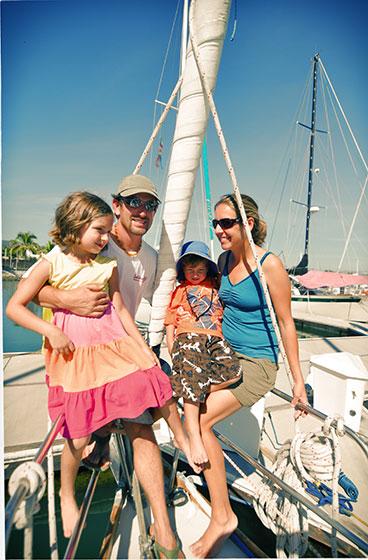
For Tucker and Victoria Bradford, cruising was a means to an end, a way for both parents to be home full-time with their kids. “In this life, our kids have two parents who have little to do but show them the world, read to them, hike with them and help them through their problems. This is important to us,” said Tucker.
The Bradfords began planning their cruise as newlyweds almost eight years ago, before their first child was born. They started with a 10-year plan: five years to eliminate debt followed by five years saving for a boat and for growing the cruising kitty. But about five years into their plan, they found Convivia, made an offer, and bought her. They moved aboard shortly afterward and lived in a marina in the year before casting off.
The family’s ultimate goal is to circumnavigate, but they’re not in a hurry. They want to show their kids as much of the planet as they can along the way, and they’ll likely stop to work at some point before continuing on. “We had to go,” Tucker says. “It was our time. Cruising for us is like living in poverty with panache, but we’re all fulfilled in a way we couldn’t have been in our work-a-day life in California.”
For any would-be cruising family, the Bradfords’ advice is to know when to quit. They repeat what countless others have said: You’ll never have enough money, and your boat will never be ready, so you must set a reasonable date and cast off. I asked Tucker why he thinks more families aren’t out here doing this. “I hate to say this, but I think that mostly, people are afraid,” he said. “I know I was. I know I had panic attacks. I knew we were doing the right thing, but it’s scary as hell to venture away from the beaten path, away from security. I’ll say this to anyone else who’s sure they want to do this but suffers the occasional creeping doubt—jump.”
Ruby, 7, and 4-year-old Miles have adapted well. They both knew since birth that this was their lot, so neither was caught off guard. For them, the most difficult part of cruising is the transition. “Saying good-bye is always hard,” said Tucker. “But they process it directly, big tears, lots of conversation, and then they move on.”
Learn more about this cruising family on their website.
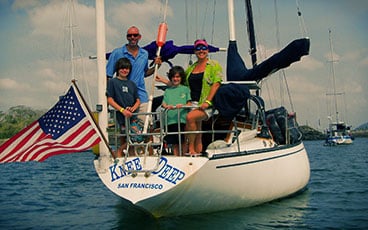
For Ben Doolittle, cruising was a life-long dream. He got a taste of it in his 20s, then remained focused on the goal to get out here again. When he chose his career, he decided to sell insurance, knowing that ongoing payments from residuals would help to sustain a cruise.
For Molly Doolittle, a former public-school teacher, cruising is a way for her boys to learn through real-world experience. “I took our oldest son to the ballpark on opening day a few years ago,” she said. “Two old men we sat next to asked Mickey why he wasn’t in school. Mickey told them how much he loved baseball and how his mom had let him skip school to catch opening day in person. The two nodded and looked at my son and one said, ‘Well, you’ll learn more here than you would in school.’ I thought he was dead on.”
The two parents report that the transition for their family has gone smoothly. The amount of time they spend together has increased exponentially, given the living, eating, sleeping, and playing together that they do every day. The boys love the wildlife encounters afloat. Molly is happy that, in addition to exposure to dolphins and turtles and whales, her kids are seeing firsthand that following a passion and living a dream are possible. She’s come to thoroughly enjoy sailing and looks forward to the night passages. The only concern she and Ben have is how to re-enter “normal” society when this is over.
When I asked about the advice they’d give others, both said that overcoming fear is an important step. They said it’s easy to get lost in the what-ifs related to injuries, storms, falling overboard, and running out of money. But once you consider how dangerous it is to drive your car on a Southern California freeway, fear is no longer a reason for not going. And you have to be ready to go: “We found a screamin’ deal on an older Catalina 38,” said Ben. “We were patient, and the right boat came along. The key was being ready to pull the plug on our life and go. When that time came, we pulled the plug and left.”
Molly was quick to note that as much fun as they’re having, cruising isn’t for everyone. “Some people would truly be miserable living this life. That’s what I’d like my children to learn as well: What works for some people doesn’t work for others. Don’t judge it.” Ben agreed, saying that taking off to live and travel as we do—on water or land—is pretty rare in all cultures. “It’s a weird, unique group of people who choose to do this,” he said. “We’re modern-day gypsies.”
Follow the Doolittles on the blog Doolittle Cruising.
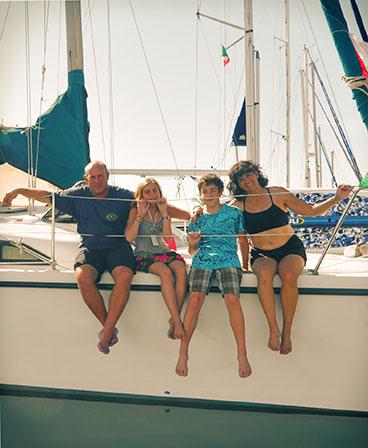
For the past 18 years, John and Toni Grippo have mostly maintained a lifestyle whereby they work hard for six months in the United States, then play hard for six months in Mexico. For the past couple of years, their Mexico playtimes have been aboard Popoki, a 1996 Gemini 105. They had a previous boat, and during times between boats, they went camping or took road trips, including a jaunt down to Panama and back.
In California, John works as a journeyman lineman, and he has no trouble getting work maintaining and updating the state’s aging high-voltage infrastructure. In Mexico, he’s a sailor, surfer, and all-around waterman. Toni homeschools both their kids—no matter what country they’re in—and otherwise manages the two teenagers and Kit Kat, the family’s 7-year-old Akita.
Unlike some of the other cruising families, the Grippo children have never known another lifestyle, so for them, there was no transition. “I’ve noticed that at the five-month mark, wherever we are in the world,” said Toni, “both kids start talking about when they’re going on their next trip or when they’re going back to the States. I guess that means they’re attuned to when it’s time to move on to another part of our life.”
Toni sees an upside to the transient life they lead. “I’ve often remarked that I feel more American when I’m out of the States, and Mexican when I’m back in the States. I see the advantages and disadvantages of both countries and cultures. I hope that our kids are also seeing these things and that their observations and experiences improve any area of the world they’re in—just as I hope that John’s and mine do.”
Their advice to those who wish to follow in their wake is to get disciplined about saving and spending money. “John and I have always worked to save the money for our next trip. Lots of cruisers do it this way. They sail when the weather is good, then return home only to work and save for the next cruise.”
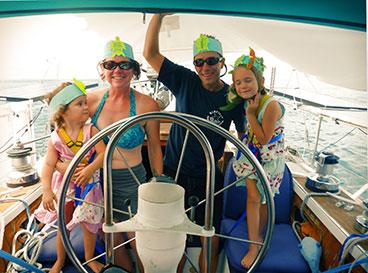
In their 20s—and before kids—Michael and Sara Johnson left Seattle and cruised between Alaska and Mexico. They’ve since owned and lived aboard various boats. They enjoy the thrill of traveling the world in their home and have found that having kids along makes it even better. “Seeing the trip through their eyes makes us notice aspects of this lifestyle that we never did when we were just a couple. Besides giving them a unique view of the world, we want to instill in them the belief that they can do anything they want to do and that there’s no need to follow the school-college-marriage-house-kids-work-retirement script.”
While the Johnsons have been out only six months so far this time, Sara reports that “we’ve become much closer than we ever were while doing the whole work/school routines. And it’s not just getting to know each other better. We get many opportunities to work on being more patient and compassionate with each other since frustrations can quickly escalate when you live in a small space.”
When asked how the kids are faring as cruisers, the Johnsons report that their girls seem to like the life of perpetual travel. “They’ve really enjoyed and been fascinated with experiencing new places and cultures,” said Sara. “But we do worry about the stresses of this transient life, the lack of routine on many days, and saying hello and good-bye to friends all the time.”
Michael and Sara believe that even with a modest income, any family with cruising dreams can head out for a year or more by taking three steps. First, get rid of all debt. Second, buy a modest boat and live aboard. Third, save like crazy by thinking of every purchase in terms of whether it’ll advance your cruising goals.
“Our best advice is to ignore people who say that what you want to do is impossible,” Michael said. But he added that accepting risk is probably the limiting factor for most families. “We don’t have boat insurance or health insurance, as these would put a cruising budget out of reach for us.”
Follow the journey of the Johnson family at their website.
The Robertson family is planning to spend the summer cruising in the waters off British Columbia and Alaska.








